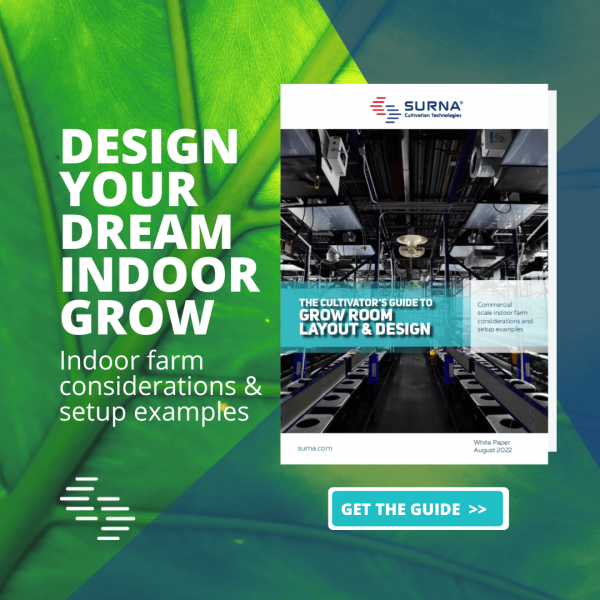As our industry continues to search for ways to maximize efficiencies, the utilization of LED lighting is becoming increasingly common. Aside from energy efficiency gains, one of the many benefits of migrating to LED’s is the ability to also maximize space utilization. With less radiant heat and more consistent PPFD, cultivators are able to move lighting much closer to the plant canopy (in some cases less than 6”), which makes vertical, or multi-tier, cultivation far more feasible than with HID lighting.
The obvious benefit to tiered applications is the ability to increase canopy square footage without additional building square footage. Although there are some drawbacks to multi-tier growing, there can also be great reward, and so we’re seeing more and more of our clients choose to go this route in their facilities.
From an HVAC Perspective
The challenge with multi-tier cultivation is twofold: first, we must ensure homogeneity to the entire canopy at multiple heights (that all plants at all levels are seeing the same conditions), and second, we must ensure that the HVAC system is getting adequate access to the hot, humid canopy air to ensure that it operates at full capacity.
When standalone dehumidifiers are in use (as opposed to integrated dehumidification systems), it’s doubly important. Dehumidifiers are typically ceiling mounted and getting the humidity from the lower tier all the way to the ceiling is both difficult and absolutely vital to the proper operation of the dehumidification system. These requirements can be challenging even in single tier applications, so when the complication of airflow obstructions associated with multiple tiers of canopy are added into the mix, the need for specialized expertise becomes even more evident.
Unfortunately, it can be exceptionally difficult for cultivators to find and incorporate a well-designed airflow system for their racking design. While something is certainly better than nothing, one-size-fits-all strategies without the proper engineering can be difficult to dial in, often resulting in improper air speed over the canopy, uneven temperatures, higher than necessary cost or higher than necessary energy use in both HVAC and the air distribution system itself.
The Variables Must be Considered
Various lengths of ductwork, various canopy heights, and various distances from the lighting source will all result in variances in airflow requirements. The speed of the airflow, the diffusion of the airflow, and the temperature of the air will all impact VPD and plant transpiration. As even LED lights vary in wattage and sensible heat output, so should the amount of air being displaced over the canopy to ensure that temperature goals are met.
While certain components of racking airflow systems can be utilized in multiple applications, some care must be taken in each application to ensure that the components being applied are appropriate—from duct diameter to static pressure and fan selection to diffusion strategies. And this is only contemplating what is required to deliver cooler, dryer air to the canopy. Delivering the hot, humid air to the air conditioning and dehumidification system must also be considered. Luckily, these are all challenges that can be addressed with the right experience and engineering expertise, and it doesn’t have to cost an arm and a leg.

The Racking Airflow Design Should be an Integral Part of the HVAC Design
We are very happy to help any cultivator retrofit their existing racking systems with a well-designed airflow system, regardless of the HVAC system in use. With the proper engineering behind them, these retrofits can solve homogeneity and airflow challenges quite nicely and at a reasonable cost.
By the same token, what we find is that the most cost effective and energy efficient multi-tier airflow strategies are those incorporated from the get-go as part of the HVAC design. Looking at it objectively, of course these systems should be incorporated at the HVAC design level when possible. Incorporating airflow over the canopy is a natural extension of the HVAC system. However, historically the industry has seen it as a separate challenge, or as a component of the racking systems themselves, and has largely considered only canopy air movement without considering how to ensure the HVAC system impacts the design.
Consistent Airflow is Achievable if Designed Right
The fact of the matter is, integrating the airflow systems with the racking systems is the easiest part. The hard part is making sure the airflow systems themselves are correctly designed to achieve their actual purpose: helping provide a cultivation environment that is consistently perfect.
When the multi-tiered airflow strategies within a room are considered as part of the HVAC design, all of the various airflow systems in the room are working in harmony instead of competing and interfering with each other, ensuring that everything operates as it was intended. This approach also minimizes the amount of equipment being utilized to achieve air distribution goals, which minimizes capital costs, overall connected electrical load, and energy use. It can even boost the energy efficiency of the HVAC system itself, by ensuring that air handlers have greater access to the hot, humid air at the canopy.
In any multi-tier application, a well-engineered racking airflow system design is an absolute requirement. However, we must stop thinking of these systems as components of racking, or as a design afterthought, and start thinking of them as an important part of the overall HVAC strategy.
Whether designing the system at the beginning of the room HVAC design, or incorporating it after the fact, engineering and expertise that implements the racking airflow system as a vital component of the overall HVAC strategy will always yield the best results.
Talk to us about our newly introduced StrataAir™ racking solution for optimal airflow designs in tiered layouts.

